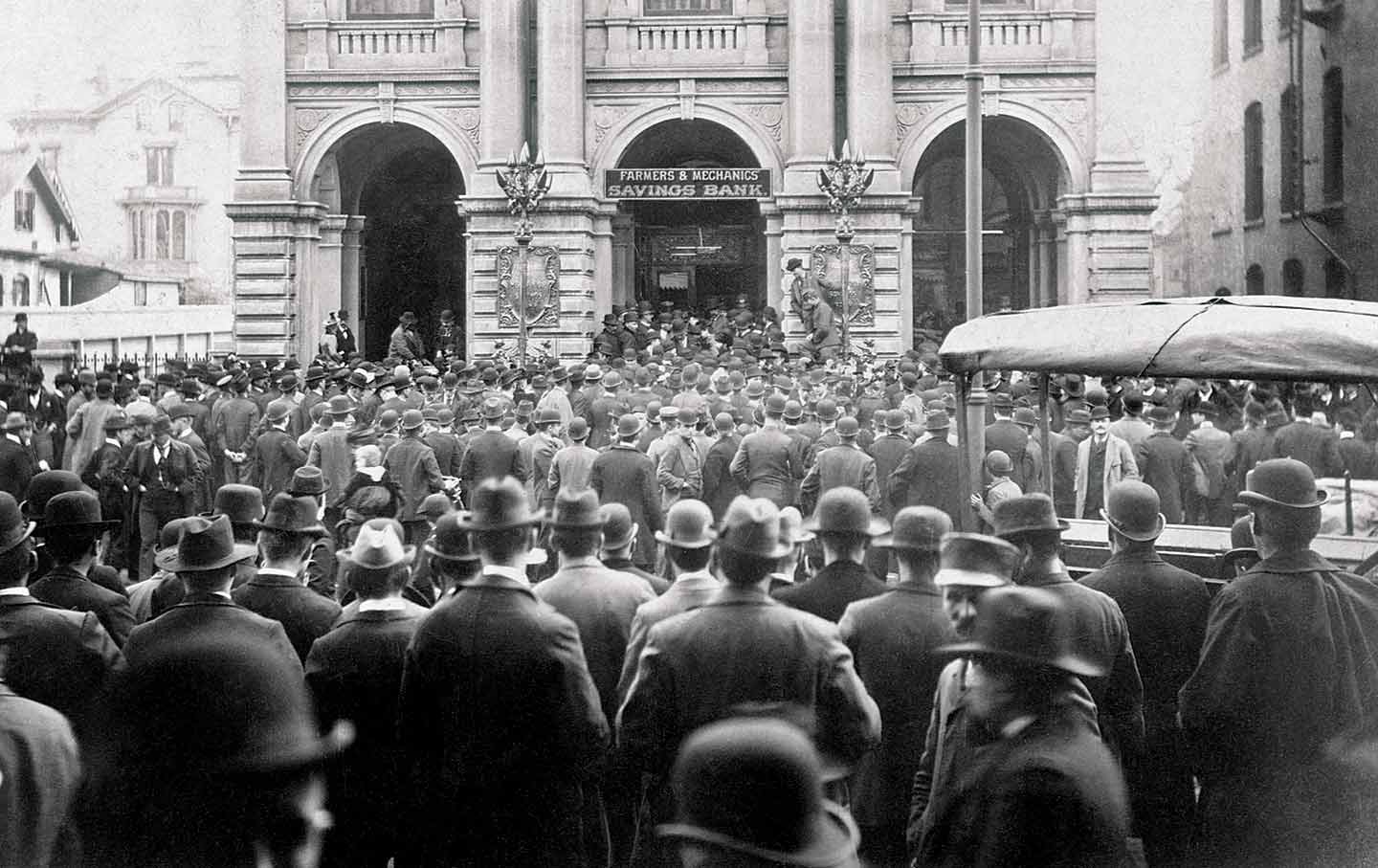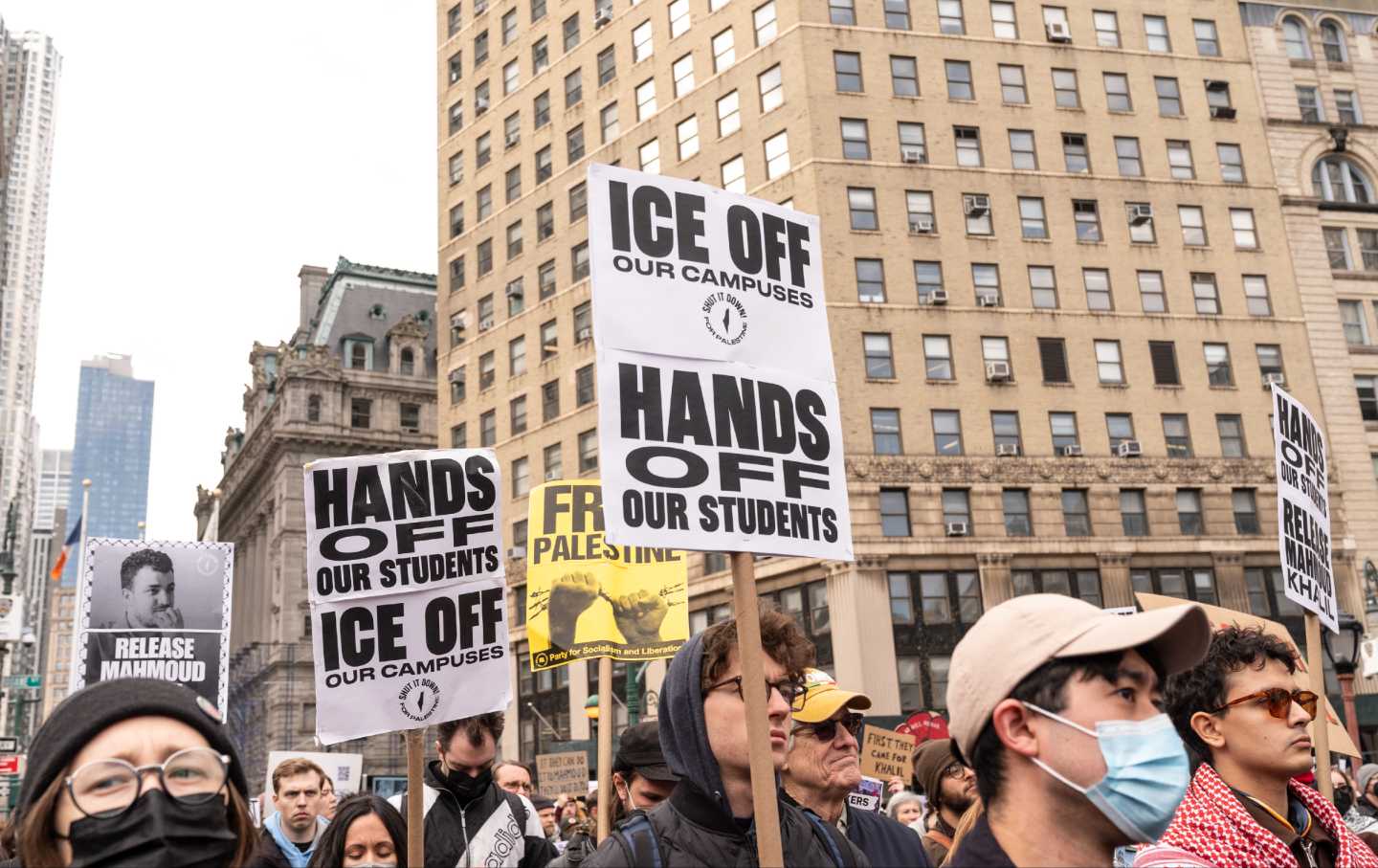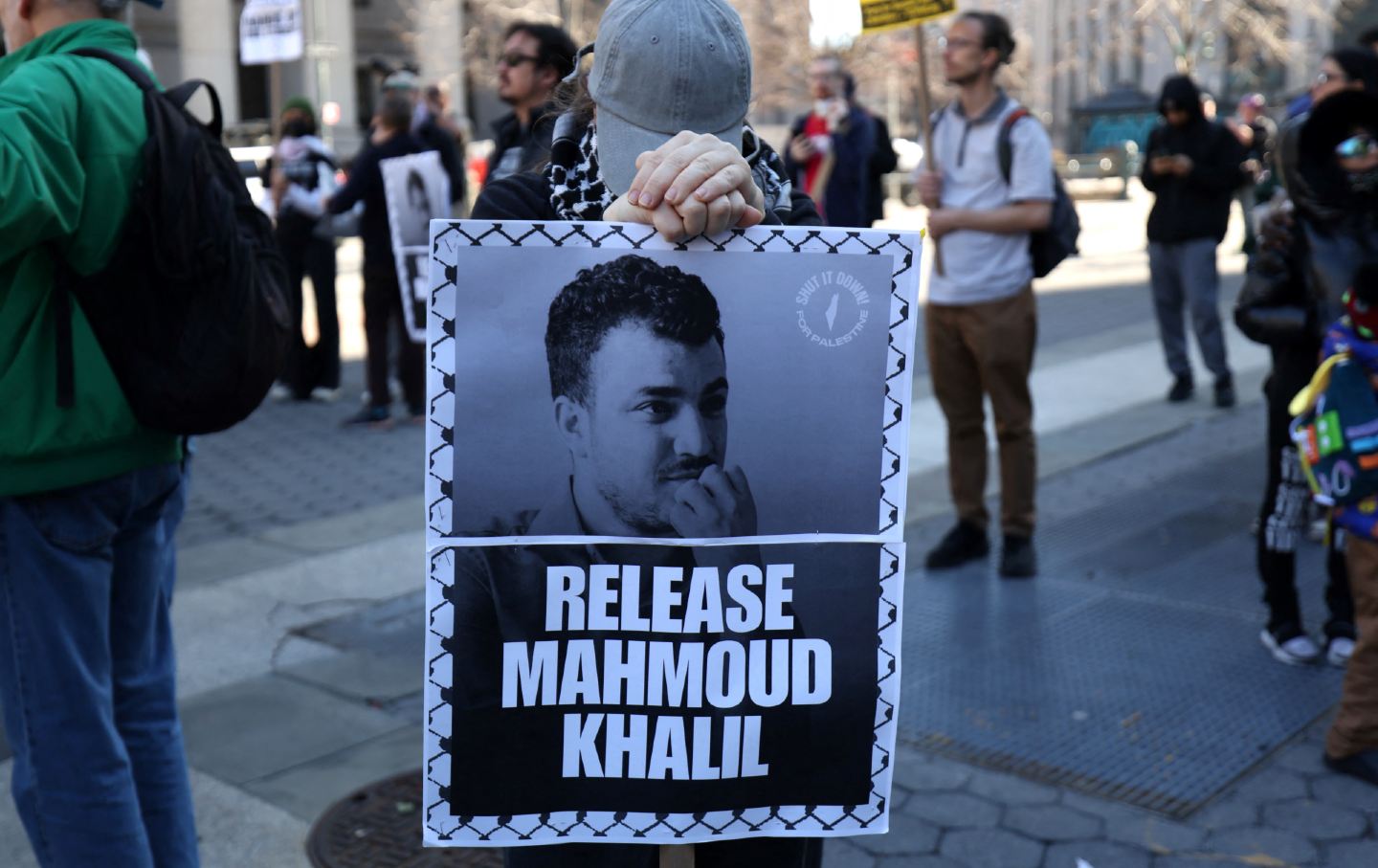A Means to Live
The past and future of debt resistance
The Radical Past and Future of Debt Resistance
The deep roots of debt relief activism in the United States.

A crowd outside Minneapolis’s Farmers and Mechanics Savings Bank during an economic crisis in May 1893.
(Getty Images)
“Early in January at Le Mars, in northwestern Iowa, a mob of a thousand farmers seized the attorney for an insurance company, dangled a rope before his eyes, and threatened him with immediate lynching.” So begins an article by the journalist Charlotte Prescott, published in The Nation in February of 1933. In the first paragraph, Prescott informs her readers that the protesters then “held the judge of the district court a prisoner in his chambers and defied the county sheriff.” She also notes that the farmers won: Soon after, local officials withdrew foreclosure proceedings against one farmer and tossed out a judgment against another. A “social revolution in the cornfields of Iowa,” a wholesale revolt of the rural population against the authorities, was under way.
Books in review
The Political Development of American Debt Relief
Buy this bookThe Iowa rebellion was no isolated skirmish. In the 1930s, indebted farmers fought foreclosure across the heartland. They organized to protect one another’s homes and livelihoods and campaigned for politicians who vowed to represent their interests, preventing land seizures through direct action and at the ballot box. Yet as impressive as this surge of populist fervor was, it represented only one chapter in a much longer conflict between debtors and creditors in the United States—a conflict that is foundational to American politics and yet, for some reason, is mostly forgotten.
The Political Development of American Debt Relief, a fascinating new book by Emily Zackin and Chloe N. Thurston, seeks to recover this history. It is not a full account of how we got into the overleveraged bind that now sees Americans carrying a collective $17 trillion in household debt. Nor does it document every movement seeking to give the indebted relief. But it does provide some critical episodes in the story of both. As Zackin and Thurston show, the ongoing battle between the owing and owning classes has deep roots in American history—from Shays’s Rebellion in the 1700s, to Dust Bowl farmers radicalized by predatory mortgages, to the more recent campaigns against student loans, back rent, and carceral fines and fees. Ordinary people have struggled under the burden of personal debt since the founding of the country in 1776, and they have struggled against that burden for just as long.
Granted, I’m hardly a disinterested reader. I’ve been part of the effort to organize debtors since the chaotic days of the Occupy Wall Street movement—an effort that the authors refer to in the introduction and the conclusion of their book. In 2014, I helped found the Debt Collective, an experimental union of debtors that has pushed the once-fringe ideas of student and medical debt cancellation into the political mainstream through a range of tactics that have included public education, protest, and economic disobedience (such as debt strikes). By opening a window onto the bygone movements of the indebted, Zackin and Thurston remind present-day debt activists that despite the seeming novelty of our approach, our efforts are not as original as we might like to think. The relatively recent emergence of debtor organizing is, in fact, a reemergence—a revival of a long-standing American tradition.
Consistently attentive to the power struggles that inform public policy, The Political Development of American Debt Relief shows how laws are shaped and reshaped by citizen action—and, just as critically, by its absence. Laws are written, thrown out, reinterpreted, and enforced (or not enforced) depending on how much, or how little, debtors are involved in politics and how much leverage they can muster and wield.
Zackin and Thurston begin their history in the late 18th century. Today, a quick Google search will confidently inform you that “personal bankruptcy is a fundamental Constitutional right.” But as the authors show, things were not always so clear-cut. The provision of “government protection from insurmountable debt” is a “very old feature of US history,” but not a foundational or immutable one. The current consensus that the Constitution empowers Congress to insert itself between creditors and their debtors in order to protect the latter was anything but self-evident at the nation’s founding. Following the British example, and reflecting the founding fathers’ class biases (including a hostility to what James Madison called the “wicked project” of debt abolition), US bankruptcy laws were initially extremely punitive, seeking to help the creditor recover debts from borrowers. While Article I, Section 8, of the US Constitution authorizes Congress to enact “uniform Laws on the subject of Bankruptcies,” the provision was adopted not to aid the insolvent but to shield lenders. The creditor class, predictably, viewed the debts owed to them as assets—as property. In their view, anything that diminished their ability to collect those debts therefore infringed upon their otherwise sacrosanct property rights.
Debtors and aligned politicians pushed back on this plutocratic framework beginning in the late 1700s. As Zackin and Thurston write, they “did not consider property rights the sine qua non of constitutional freedom but instead weighed their protection against the vulnerability of citizens in times of hardship,” and their activism slowly but steadily changed the terms of the debate. Creditors, they argued, possessed an unjust power to subordinate people not only in the economic realm but also, as a result, in the political realm: The structure of debt and the risks of penury or prison meant that one class of US citizens possessed the unjust ability to dominate others.
By the early 19th century, debt-relief activists had begun to win a series of victories against creditors. A movement to abolish debtors’ prisons started to gain traction, leading many states to abandon the practice. In 1830, Congress passed a law preventing the incarceration of insolvent Revolutionary War veterans. And over the course of the century, using its constitutional powers, Congress also passed a series of bankruptcy laws that would eventually prove beneficial to debtors.
Whose interests those laws would serve was a matter of perpetual dispute. The Bankruptcy Act of 1800 was repealed three years later; the 1841 Bankruptcy Act was repealed in 1843; and the one passed in 1867 was repealed in 1878. Only the Bankruptcy Act of 1898 managed to endure and help make federal and state bankruptcy laws markedly—even remarkably—debtor-friendly compared with those of other countries by the end of the 19th century. Over time, bankruptcy laws were tempered, if not transformed, from laws of punishment to laws containing the protections that we now take for granted. The American legal regime evolved to enable not only the enforcement of debt contracts but their alteration and even termination.
To take one example: Modern borrowers can declare bankruptcy and thus commence proceedings to clear some of their accounts. During the mid-1800s, however, the idea of “voluntary” bankruptcy (one declared by the owing party) was mocked by creditors, who sought to keep the power to initiate bankruptcy proceedings to themselves. The old English system on which the US system is based empowered creditors to accuse debtors of committing “acts of bankruptcy,” which ranged from nonpayment to leaving town to hiding assets. Some of these acts were capital crimes, punishable by death.
It was indebted farmers who did the most to undermine creditor-friendly constitutional doctrine, and they did so initially by organizing at the state level. Between 1819 and 1934, 42 of the country’s then 48 states passed or renewed laws that offered retrospective debt relief, making it illegal for creditors to seize certain kinds of property in response to insolvency, regardless of the initial terms of the agreement. Debt relief, Zackin and Thurston argue, was in fact more than just a matter of releasing the insolvent from what they owed; it was a form of early public welfare provision—an “older form of social insurance,” they contend, established before the emergence of the administrative state as we currently know it. Bankruptcy mechanisms enable the insolvent, at least under certain circumstances, to achieve a fresh start. In the words of a 1934 Supreme Court decision, bankruptcy law “gives to the honest but unfortunate debtor…a new opportunity in life and a clear field for future effort, unhampered by the pressure and discouragement of preexisting debt.”
Along with an ascending politics of welfare and social security, debt politics was also inseparable from questions of race and white supremacy. The short-lived Bankruptcy Act of 1841, Zackin and Thurston note, may have helped move the needle of bankruptcy in favor of debtors. But at the same time, it had “close ties to westward expansion” and functioned as an intraparty pact that advanced settler colonialism by propping up the mythic white yeoman farmer while also facilitating the dislocation of Native Americans in the West.
In the antebellum South, similar dynamics played out to ill effect. After the Civil War, Southern states passed emergency relief statutes, including exemptions to the kinds of property that could be seized by creditors, in response to the widespread economic devastation. This protected the landholdings of small-scale farmers while also shielding the property of large-scale former plantation owners. For some Republicans, this was a political maneuver as well: They hoped the promise of debt relief would help them attract white voters in their aim of forging a multiracial coalition. But debt relief without land reform risked further strengthening the racial hierarchy that Republicans sought to overthrow. No wonder, then, that Georgia’s Black Constitutional Convention delegates tended to support means-tested or limited debt relief instead of programs that “benefited rich and poor debtors indiscriminately.” As one formerly enslaved man reportedly said: “The freedman cannot be benefited by the measure. They owe no debts.”
The freedmen were right to be dubious. “Through its approach to debt relief, the federal government helped to protect property-owning white planters from economic risk, allowing them to reestablish their social and economic positions, while contributing to the cycle of debt that resubjugated landless Southerners,” Zackin and Thurston explain. Landless Black voters didn’t need laws that protected homesteads from creditors; they needed homesteads of their own.
Meanwhile, after having availed themselves of its benefits, white landholders lobbied for an end to debt relief—which they achieved when the Bankruptcy Act of 1867 was repealed. Soon enough, creditors banded together to advocate for a new regulatory framework that they hoped would streamline their ability to secure repayment by simplifying what at the time was a mosaic of sometimes conflicting state regulations. Commercial associations of creditors, generally represented by the Republican Party at this point, were the driving force behind the new legislation, and so, as a result, indignant and increasingly insolvent farmers turned to Populist and Democratic officials, demanding that debtors’ interests be protected as well.
Like Reconstruction, the Great Depression proved to be another turning point in the history of debt relief and debtor activism. During this period, Zackin and Thurston write, “Congress developed a generous protective policy for one group of debtors (farmers) while taking a far less sympathetic stance towards another (wage earners).” The former group was well organized, but the latter was not—at least when it came to debt politics. The Frazier-Lemke Farm Mortgage Moratorium Act of 1934, which prevented mortgage holders from foreclosing on a farm for five years, also granted farmers the opportunity to buy their farms at the current deflated price and a favorable interest rate. The National Farmers Union sprang into action to prevent the Supreme Court from nullifying the law, which the justices did in 1935, arguing that the rights of mortgage issuers had been violated. Soon, and thanks to NFU organizing, the New Deal Congress passed an amended version of the act designed to withstand constitutional review while offering almost identical protections.
Even while farmers made gains, however, the very same congressional representatives created a regulatory regime that disadvantaged indebted wage earners, who had no group comparable to the NFU to advocate for their interests. Instead, the new provisions passed by the New Deal Congress were conceived by creditors, bankruptcy officials, and employers “eager to prevent indebted wage earners from escaping their debts.” Under their guidance, Congress created rules that encouraged debtors to forgo standard forms of debt relief and instead submit to extended, court-supervised repayment plans. As Zackin and Thurston note, this meant that instead of collecting on debt by seizing a borrower’s assets (something few indebted wage earners possessed in abundance), creditors could instead collect from the debtor’s future income or wages—a far more lucrative arrangement for the lender.
Farmers had built a powerful and militant movement that challenged the idea that debtors were to blame for their economic woes: “They claimed that those who could not repay their debts were innocent victims of forces beyond their control and that they were therefore deserving of government’s protection from their contractual obligations and creditors,” Zackin and Thurston write. Without an organization to defend the interests and reputations of wage-earning debtors, creditors set the agenda, and they did so in part by painting struggling borrowers as profligate, immoral, and undeserving of government assistance. Organized labor did little to help the cause of the financially ruined, despite the fact that many rank-and-file members were in hock. At the time, union leaders were far more concerned with ensuring that their members could access credit than they were with fortifying debtor protections. The more mainstream corners of the civil rights and women’s movements would follow suit, focusing on increasing the availability of credit rather than on curbing creditor power or creating economic conditions under which borrowing would be less necessary.
The folly of this approach is now clear. Today, women and Black and brown borrowers are disproportionately burdened across an array of debt types, their economic prospects weighed down by payday loans, medical bills, credit card payments, student debt, subprime auto loans, and the like. Communities that lack intergenerational wealth and face discrimination on the job are often charged higher interest rates and have a harder time paying off their debts; they rarely experience the benefits of borrowing enjoyed by their more affluent counterparts, a phenomenon known as “predatory inclusion.”
Popular
“swipe left below to view more authors”Swipe →In 1978, Congress replaced the Bankruptcy Act of 1898 with a surprisingly debtor-friendly new law—surprising given that it did so with little to no input from ordinary borrowers; creditors were also largely absent from the drafting process. Instead, the new rules, which made filing for bankruptcy easier for debtors and increased the dollar amount of certain assets they could withhold, were mainly influenced by academics, lawyers, and judges—“bankruptcy professionals,” as Zackin and Thurston call them. Yet while this was a relative victory for the insolvent, the future tilt of government policy was better exemplified by the Supreme Court’s decision that same year to permit credit card companies to bypass state usury laws, which caused interest rates to spike and supercharged the credit card industry. The absence of membership-based organizations and advocacy groups committed to fighting for the modicum of protections that debtors possessed gave creditors the upper hand as a new era of market triumphalism commenced. Corporate interests, including lenders, got organized and lobbied aggressively and successfully. With their support, the hostility toward wage-earning debtors that took root in the 1930s blossomed in the 1980s and ’90s. The mere use of welfare programs and bankruptcy protections became illustrative of individual fault rather than inadequate remedies for the inevitable harms of a profoundly unequal economic system. This unforgiving ideology informed the 2005 Bankruptcy Abuse Prevention and Consumer Protection Act, passed in large part due to the tireless advocacy of then–Senator Joe Biden of Delaware. The act undermined borrower protections on multiple fronts (for example, by making it practically impossible to discharge private student loans) and prompted a wave of foreclosures that foreshadowed the 2008 mortgage crisis.
Compared with their agrarian predecessors, the inability of contemporary debtors to repay debt has become highly stigmatized. Ordinary people are typically said to be carrying “consumer debt,” a phrase that obscures the fact that much of this debt is incurred so that its holders can do things such as go to the doctor or dentist, attend college, or buy food. Consumers are, of course, central to the functioning of the economy, but lionized yeoman farmers they are not; the word “consumer” implies choice, and so it reinforces the notion that most debtors have simply made bad choices. Poverty is portrayed as a personal failing rather than the product of bad policy.
This is the moral framework that the Debt Collective has been pushing back against for the past decade. In our campaigning, we reject the usual framing of debt “forgiveness” on the grounds that most debtors have done nothing wrong and therefore need no forgiveness—instead, we call for relief, cancellation, and abolition. It’s no surprise that the majority of people are in arrears when the federal minimum wage is frozen at $7.25 an hour and the cost of living climbs ever skyward.
The Political Development of American Debt Relief offers important history lessons and even some strategic insights for those of us who are determined to change this situation. Though we cannot devise a strategic blueprint for the fight ahead simply by studying the past, we could, at a minimum, marshal a bit more of the impecunious farmers’ indignant fire. Just as critically, the burgeoning movement focused on debt cancellation must be coupled with a larger political transformation that addresses the root causes of mass indebtedness. Debtors and their allies cannot afford to repeat the mistake of fighting for “fair access to credit”—for the ability to finance the necessities of life on marginally less extractive or biased terms. The vast majority of debtors today are not living beyond their means; rather, they are denied the means to live. Tens of millions of people urgently need debt relief. But we also all need something more radical: the guarantee of free, high-quality, and reparative public housing, healthcare, education, and transit for all so that no one is forced to borrow to survive in the first place.
Support independent journalism that exposes oligarchs and profiteers
Donald Trump’s cruel and chaotic second term is just getting started. In his first month back in office, Trump and his lackey Elon Musk (or is it the other way around?) have proven that nothing is safe from sacrifice at the altar of unchecked power and riches.
Only robust independent journalism can cut through the noise and offer clear-eyed reporting and analysis based on principle and conscience. That’s what The Nation has done for 160 years and that’s what we’re doing now.
Our independent journalism doesn’t allow injustice to go unnoticed or unchallenged—nor will we abandon hope for a better world. Our writers, editors, and fact-checkers are working relentlessly to keep you informed and empowered when so much of the media fails to do so out of credulity, fear, or fealty.
The Nation has seen unprecedented times before. We draw strength and guidance from our history of principled progressive journalism in times of crisis, and we are committed to continuing this legacy today.
We’re aiming to raise $25,000 during our Spring Fundraising Campaign to ensure that we have the resources to expose the oligarchs and profiteers attempting to loot our republic. Stand for bold independent journalism and donate to support The Nation today.
Onward,
Katrina vanden Heuvel
Editorial Director and Publisher, The Nation
More from The Nation

“I’m Terrified”: Trans-Feminine Athletes in Their Own Words “I’m Terrified”: Trans-Feminine Athletes in Their Own Words
In part two of a series, trans women athletes describe what it’s like to compete in the Trump era.

Columbia Is Betraying Its Students. We Must Change Course. Columbia Is Betraying Its Students. We Must Change Course.
The administration is choosing complicity over courage in the case of Mahmoud Khalil. It’s time for the faculty to demand a new path.

The Trans Cult Who Believes AI Will Either Save Us—or Kill Us All The Trans Cult Who Believes AI Will Either Save Us—or Kill Us All
What the Zizians, a trans vegan cult allegedly behind multiple murders, can teach us about radicalization and our tech-addled politics.

We Are Asking the Wrong Questions About Mahmoud Khalil’s Arrest We Are Asking the Wrong Questions About Mahmoud Khalil’s Arrest
The only relevant question is not “How can the government do this?” It is “How can we who oppose this fascist regime stop it?”

DOGE’s Private-Equity Playbook DOGE’s Private-Equity Playbook
Elon Musk's rampage through the government is a classic PE takeover, replete with bogus numbers and sociopathic executives.

White Flops Rejoice! White Flops Rejoice!
DEI is being snuffed out in DC. Mediocre whiteness reigns. And we’re all going to suffer for it.


